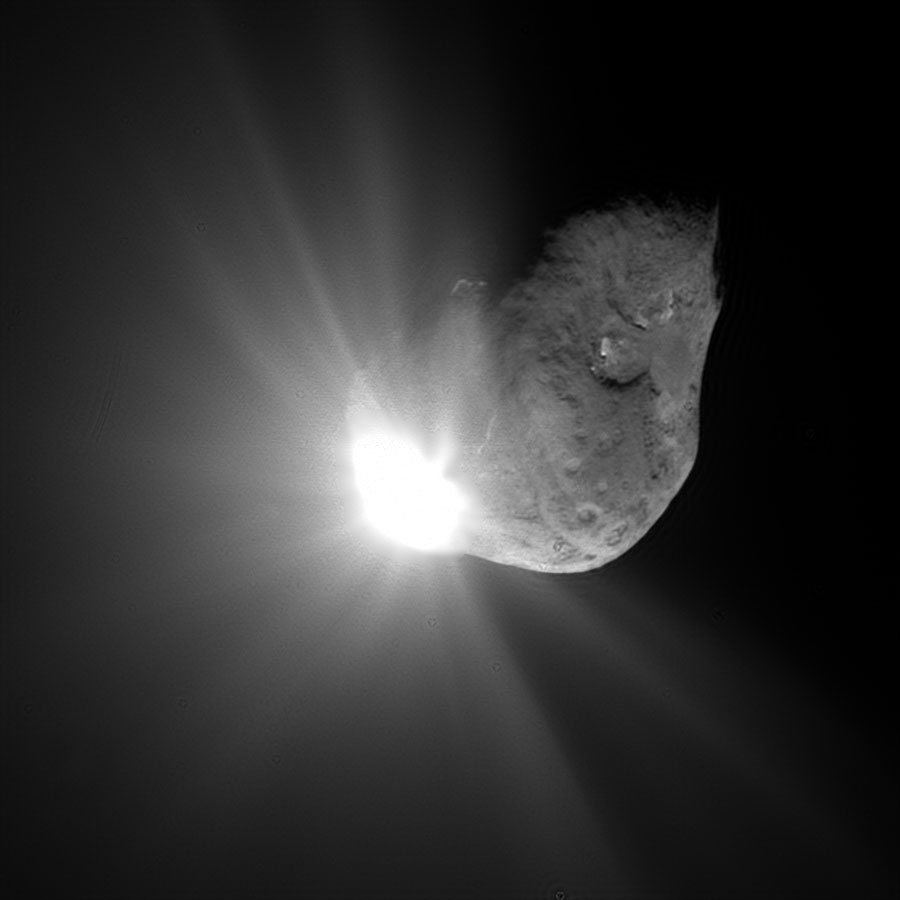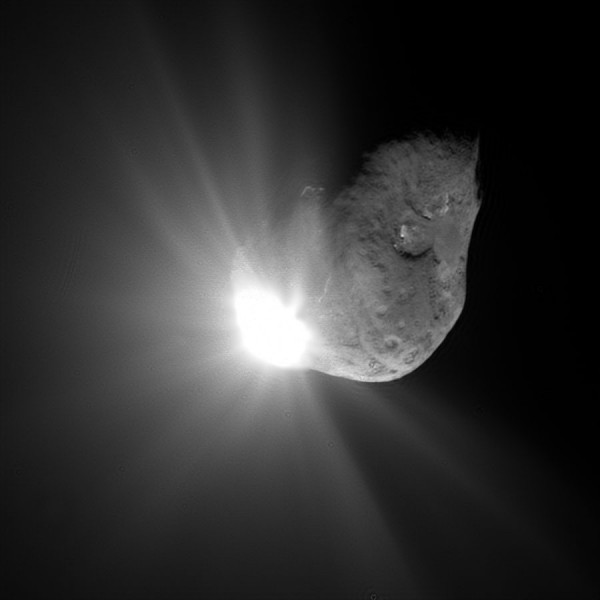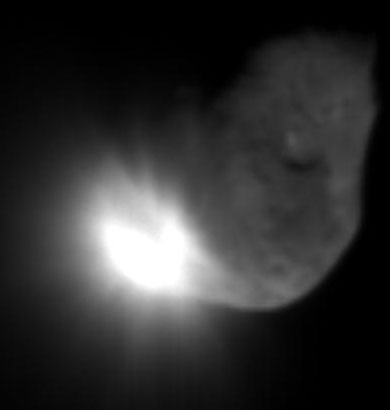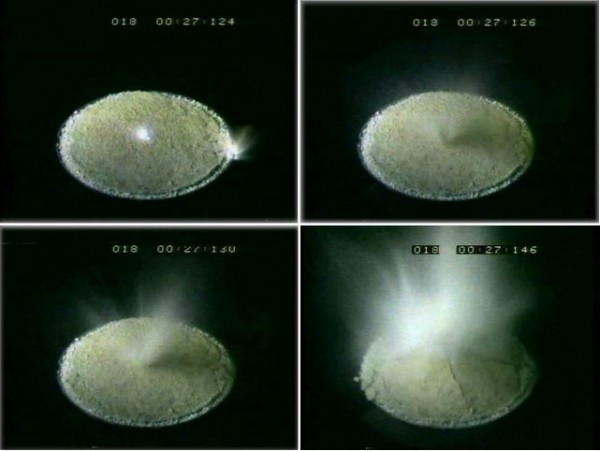holoscience.com | The ELECTRIC UNIVERSE®
A sound cosmology for the 21st century

Comet Tempel 1’s Electrifying Impact

It is now little more than a week since the spectacular hyper-velocity meeting of Comet Tempel 1 with a copper projectile sent from Earth. Preliminary results of the Deep Impact experiment are being reported from telescopes in space and around the world. However, it may be months before a detailed assessment of the experiment is publicised. It is to be hoped that the delay is not due to experts’ need to be seen as capable of explaining everything in terms of their beliefs about the nature of comets.
Meanwhile, how did the ELECTRIC UNIVERSE® model of comets fare? The two major predictions that the outburst upon impact would be more energetic than expected and the comet is rocky, with little water in its interior, have been supported.
Before the impact scientists were concerned that there might be little to see. That is understandable when you look at impact experiments performed on Earth. Below is the initial sequence from a movie showing a high-speed impact into a frozen comet-like material (dust, ice, window cleaner and Worcestershire sauce) over a highly porous target (garden perlite).
See the movie at: deepimpact.umd.edu/science/cratering.html Credit: NASA
Compare the lower-left frame with the image at the top of this news item and you will understand why the reaction to the Deep Impact by NASA scientists was “unbelievable.” The blast was “considerably more energetic than I expected.” “The big question is how did we make such a big splash?” “I’m at a loss to explain it.” The reaction was universal.
Another spectacular impact – Comet Shoemaker-Levy 9 at Jupiter
However, the brilliant outburst was expected by the electrical comet model. In October 2001 I predicted:
“..the energetic effects of the encounter should exceed that of a simple physical impact, in the same way that was seen with comet Shoemaker-Levy 9 fragments at Jupiter.”
It is worth reviewing that earlier event because the astronomical community has learned nothing in the 11 years since the crash of Comet Shoemaker-Levy 9 into Jupiter. The old dirty snowball comet model remains intact. We forget that some astronomers discouraged the public from trying to see SL-9 impact Jupiter.
“You won’t see anything. The comet crash will probably amount to nothing more than a bunch of pebbles falling into an ocean 500 million miles from Earth.”
But as Sky & Telescope reported:
“When Fragment A hit the giant planet …it threw up a fireball so unexpectedly bright that it seemed to knock the world’s astronomical community off its feet.”
Sound familiar?
The electrical effects at Jupiter of Comet SL-9 were prodigious for “a bunch of pebbles.” The Hubble Space Telescope (HST) detected a flare-up of fragment G before impact at a distance of 2.3 million miles from Jupiter. It occurred as the fragment crossed Jupiter’s plasma sheath, or magnetospheric boundary. A plasma sheath, or “double layer,” is a region of strong electric field, so the outburst there of an electrified comet nucleus is expected. The outburst was a surprise to astronomers. Hubble’s Faint Object Spectrograph (FOS) recorded strong emissions from fragment G of ionised magnesium but no hydroxyl radical (OH), expected from water ice. Also, after the flare-up in magnesium emissions there was a “dramatic change in the light reflected from the dust particles in the comet.”
These observations cast doubt in the minds of astronomers whether SL-9 was a comet or an asteroid. Astronomers believe the key difference is that comets are largely icy and asteroids are not because the latter formed too close to the Sun. The simple answer is that only their orbits distinguish comets and asteroids. Comets have more elliptical orbits than asteroids, which subjects the comets to a changing electrical influence from the Sun. The tails and comas of comets are simply electrical discharge phenomena and are not governed by the composition of the nucleus or solar heating. (One large asteroid, Chiron, has been observed to change into a comet and grow a coma). And several comets have flared up beyond the orbit of Saturn, where they are in deep freeze. The confusion between asteroids and comets only arises because of astronomers’ tenacity in clinging to a disconfirmed theory of comets.
Just after the impact of SL-9 fragment “K,” HST detected unusual auroral activity that was brighter than Jupiter’s normal aurora and outside its normal area. Radiation belts were disrupted. There were unexpectedly bright X-ray emissions at the time of impact. But one mystery was never explained satisfactorily:
Early impact events were hidden from the Earth behind Jupiter’s limb. However, the Galileo spacecraft was positioned 150 million miles away from Jupiter at an angle that gave it a ringside seat for these events. But Earth-based observatories saw some of the impacts start at the same time Galileo did. “In effect, we are seeing something we didn’t think we had any right to see,” said Dr. Andrew Ingersoll of Caltech. “…it seems clear that something was happening high enough to be seen beyond the curve of the planet,” said Galileo Project scientist Dr. Torrence Johnson of JPL.
None of these discoveries is surprising if comets are highly electrically charged with respect to their environment. Radio astronomers had expected radio emissions from Jupiter at high frequencies to drop because dust from SL-9 fragments absorbs electrons from the radiation belts, where the electrons emit synchrotron radiation. Instead, they were surprised to find that emissions around 2.3 Ghz rose by 20-30%. “Never in 23 years of Jupiter observations have we seen such a rapid and intense increase in radio emission,” said Michael Klein of JPL. “Extra electrons were supplied by a source which is a mystery.” It never occurred to anyone that the charged comet was the source of the electrons.
A charged comet is likely to be destroyed before impact by a massive electrical discharge, or “cosmic thunderbolt.” That explains the mystery of the flashes that should have been obscured by Jupiter’s limb and the intense burst of radiation seen from Earth. The strange dark fallout rings observed on Jupiter after the “impacts” were caused by the cosmic thunderbolts driving matter from lower levels upwards through Jupiter’s atmosphere, not by fireballs following impact. It is the same “plasma gun” effect seen on Io, where the “volcanic” fallout is also electrically constrained to form rings.
Returning to Tempel 1 and Deep Impact
The radiance of the blast “saturated the camera’s detector.” The same kind of camera detector overload has occurred before at Jupiter with SL-9 and at Io when the Galileo Orbiter tried to take a close up image of a “volcano” on Io. It is purely an assumption to attribute all of the radiance of the Tempel 1 ejecta to scattered sunlight. “The major surprise was the opacity of the plume the impactor created and the light it gave off,” said Deep Impact Principal Investigator Dr. Michael A’Hearn of the University of Maryland, College Park. “That suggests the dust excavated from the comet’s surface was extremely fine, more like talcum powder than beach sand. And the surface is definitely not what most people think of when they think of comets – an ice cube.” Well, who gave most people that idea? Unlike the impact experiment, there is no shadow evident in the blast cone, which we should expect given that NASA’s Swift satellite X-ray data indicates “several tens of thousands of tons” of dust has been blasted into the coma.
The question was immediately posed: “How can a comet hurtling through our solar system be made of a substance with less strength than snow or even talcum powder?” The answer is that it cannot. Scientists had already commented on the circular craters, dark linear scarp-like features and flat areas on Tempel 1. And earlier, when NASA’s Stardust probe took its headlong plunge through comet Wild 2 in January, 2004, Ray Newburnof NASA’s Jet Propulsion L:aboratory in Pasadena, California, said “I don’t think any of us really considered the possibility of impact craters. If the pits are craters, the surface of the comet nucleus must be much stronger than experts thought.” “It may be a well-cemented rubble pile, but it’s definitely not a loose, powdery surface,” he said. So Tempel 1 highlights the contradictions created by the conventional theory of comets because it has craters. Yet the material blasted from it appears to be mostly fine powder. Another contradiction is that a deep covering of dust on the comet is the best insulation against solar radiation and should prevent ice sublimation, making jets impossible.
The Gemini North telescope on Mauna Kea successfully captured the dramatic fireworks display produced by the collision of NASA’s Deep Impact probe with Comet Tempel 1. It shows a strong increase in silicates in the mid-infrared region of the spectrum. “The properties of the mid-infrared light were completely transformed after impact,” said David Harker of the University of San Diego, co-investigator for the research team. “In addition to brightening by a factor of about 4, the characteristics of the mid-infrared light were like a chameleon and within five minutes of the collision it looked like an entirely new object.” Harker’s research partner Chick Woodward of the University of Minnesota speculated further, “We are possibly seeing crystalline silicates which might even be similar to the beach sand here in Hawaii!” This is consistent with the rocky appearance of all close-up images of comet nuclei. Researchers at the Gemini North telescope concluded that there was strong evidence for silicates or rocky material exposed by the impact. However it requires something with the concentrated energy of an electric discharge to convert rock into finely divided annealed silicates – like talcum powder – seen in the coma. The production of an unexpected abundance of extremely fine dust, some of it comprised of only 100 atoms or so, was an unsolved puzzle of the fly-bys of comet Halley.
The electrical model of comets simply explains the “chameleon”–like change in the spectrum of the comet. Normally, the spectrum is integrated over the coma where there has been time for negative oxygen ions, which have been discovered in surprising abundance by earlier fly-bys through comet comas, to combine with solar wind protons. The OH formed gives the appearance that water is a major constituent of the comet’s nucleus. Simple sublimation of water molecules by solar heating will not produce short-lived negative oxygen ions. Another observation from the Odin telescope in Sweden may prove to fit this model. They found that the total amount of water seemed to decrease after the impact – as the researchers said – “oddly enough.”
More recently, Smithsonian astronomers using the ground-based Submillimeter Array (SMA) in Hawaii and NASA’s orbiting Submillimeter Wave Astronomy Satellite (SWAS) report seeing only weak emission from water vapor and a host of other gases that were expected to erupt from the impact site. Astronomer Charlie Qi of the Harvard-Smithsonian Center for Astrophysics expressed surprise at these results. He explained that short-period comets like Tempel 1 have been baked repeatedly by the sun during their passages through the inner solar system. The effects of that heat are estimated to extend more than three feet beneath the surface of the nucleus. But the Deep Impact indicates that these effects could be much deeper. “Theories about the volatile layers below the surface of short-period comets are going to have to be revised,” Qi said.
We have come to expect nothing more from astronomers than ad hoc revisions of existing theories. Meanwhile the contradictions pile up at their observatories. A major prediction of the electrical model of the late birth of comets (and asteroids) from well differentiated planets is that their composition will vary depending on their source but they will tend to be homogeneous and rocky. Measurements of their density will give misleading estimates of their composition because they are based on an assumption about the universality of the gravitational constant, ‘G.’ Gravity is a weak electric dipole force like the “London force” between molecules. So ‘G’ is a variable dependent upon the electrical stress within the comet. It is those electric stresses that cause comets to suddenly and mysteriously disintegrate.
What about the size of the crater? That was to be an important measurement in determining the solidity of the comet. Because the plume of gas and dust from the impact was much bigger, brighter and less transparent than expected, the crater is probably undetectable in the optical images taken by the flyby spacecraft. So the science team must resort to indirect methods. For example, it is thought the crater should be cooler than the surface if it exposed new ices. It could be revealed by the infrared images. The electrical model expects exposed bedrock which has been recently “spark machined” so that it may not be cooler than the surface. The best option seems to be to measure the width of the shadow at the base of the plume.
The electrical model of the comet predicted changes in existing jets and/or the addition of extra jets as a result of the large disturbance to the topography of the comet and the sudden addition of 840 kilograms of highly conductive copper. The jets from the blast did appear briefly to originate from two close centers, which was predicted as a strong possibility by the electric model. One crater would be electrical and the other impact generated (see below). The emergence of several extra and more pronounced jets was seen after the impact by the 2.5m NOT telescope at El Roque de los Muchachos observatory (La Palma, Spain). It should be noted that the reason for comets having well defined jets at all is not clear from the sublimating ices model.

Close-up images from the impactor showed bright spots on the comet nucleus, similar to those seen on Comet Wild 2. They may be the expected bright coronal discharge points that feed into the cometary jets. If so, they are the sites of electrical “cathode sputtering” like the bright spots and linear features seen along the edges of “caldera” walls on Io. These “cathode arc spots” are responsible for etching the sharp relief seen on comet nuclei. And like we see on Io, they leave a darkened, exposed surface when they move on. That would explain the darker rims of the craters and scarps. It is salutary to note that Kristian Birkeland, an outstanding pioneer of the ELECTRIC UNIVERSE®, demonstrated the bright spots and sputtering of metals from an electrified sphere in his famous Terrella experiments. That was more than a century ago!
There was a small flare seen before the main flash. If so, it may be the electric discharge predicted by the electrical model to occur an instant before impact. NASA expert, Peter Schultz, suggested that the flare indicates a layered structure for the comet. “My guess is there was soft layering on top, [the impactor] went down, and finally got in contact with ices.” It is suggested that analysis of the shape of the plume will give information about the depth of the crater. However, the results will be misleading if the plume is subject to focussing electromagnetic forces. It is interesting to note in Schultz’s experiment that the top left frame also has a bright flash before material is ejected. There is also a bright flash from the edge of the target opposite the light source, which suggests that a piezoelectric effect from the concussion may have generated an electric spark in that experiment. Schultz’s complicated guess for the origin of the flare is less likely than an electric discharge between the impactor and the comet an appreciable time before they made contact. An accurate assessment of the timing of the flash with the expected time of impact may provide the answer. The flashes and apparent early failure of the impactor camera deserve explanation also.
In stark contrast to NASA scientists, who seem to be perpetually surprised, the adherents of an electrical model of comets have seen many of the quite specific predictions satisfied. How many surprises and disconfirmations of cherished beliefs about comets will it require before a fundamental rethink occurs, instead of mere revision of old ideas? Science works best when there is a plurality of ideas. The present establishment monoculture of ideas is crippling scientific progress.
Wal Thornhill
